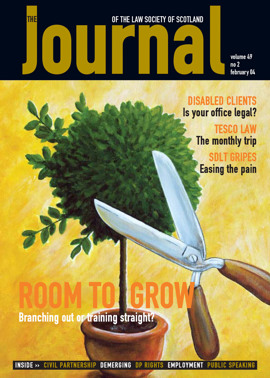Book reviews
I should first declare an interest. I am a good friend of the author and accordingly there is a reasonably substantial – if not probably foreseeable – risk that this review will be kinder than any book could possibly deserve. So to keep a proper balance, I have decided to highlight some of its shortcomings. It has not been easy and I have had to keep an eye open for pitfalls (defined in pages 182-184).
The typing must be incredibly small. No book as brief as this can possibly be as comprehensive as it appears to be (see, e.g. the chapter on damages for stress at work: pages 258-265).
There are obviously dangerous subliminal features – chapters on benefits, quantum, expert evidence, pleadings, time bar, accidents on construction sites and many other features of your everyday reparation action seem to have been slipped in without occupying any space at all.
It was clearly ghost written. No single person could possibly have found the time during a busy working life to analyse so succinctly the main ingredients of successful PI practice – or he has been swinging the lead at the office (in that connection, see the section on Manual Handling Regulations, pages 221-224).
The author is plainly deranged. No person in his right mind would have dared to summarise the complex skills of handling PI clients and cases and dared to make them seem simple (see the chapters on taking instructions: pages 1-8, and case management: pages 158-165).
There must be tons of stuff missing. No self respecting practitioner would disclose all of the tricks of the trade to his potential rivals and opponents. He must be keeping something up his sleeve (see the infuriatingly exhaustive summary on road traffic cases, pages 165-180, which includes MIB issues as well!).
The film rights will be extremely difficult to market – apart perhaps from the chapter on accidents to children: pages 264-271). There are no pictures, or sections to colour in, or quizzes – the style writ, specification of documents and schedule of damages (was that not my case? – CH) at pages 300-306 do not count, but I suppose they might come in handy now and then.
Despite these highly significant reservations, I am compelled to recommend the book for its excellent advice and practical comment on the handling of all of the major categories of PI claim. The book is written for pursuers (the single-shotters) and intended partly to assist them in overcoming the evil machinations of the defenders (the repeat players) who wrestle dismissals and cheap settlements from their opponents. For the cost of the warranting dues of a poor writ, and with the prospect of being able to improve the pleadings and the client’s prospects overnight, no pursuer’s agent should be without it. Even those who think they know what they are doing and why, will be reassured by its contents and surprised at the things they had (temporarily, of course) forgotten. It has lots of really good tips too.
Charles Hennessy
In this issue
- It's a funny old world
- Making the ends of justice meet
- Training for growth
- All the grocer's grandchildren
- Radical change or a lie in law?
- Costing the job
- Are you listening?
- Much ado about nothing?
- Demergers and continuing cover
- Bond with the audience
- Many roles, one team
- Fee sharing: making the rules work
- On sentencing
- Credit reform by instalments
- Scottish Solicitors' Discipline Tribunal
- Show us the evidence!
- A new era for farm tenancy law
- Fathers' rights: a new UK postcode lottery?
- Parallel imports: putting on the brakes
- Website reviews
- Book reviews
- SDLT 1: Over the obstacle course
- SDLT 2: Personal presentation
- The new law of real burdens
- Housing Improvement Task Force






